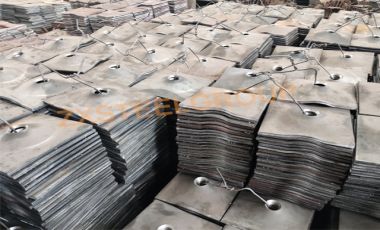
The anchor plate is an essential component used in conjunction with a split set stabilizer to provide ground support in underground mining and tunneling operations. It helps distribute loads and anchor the stabilizer firmly in the surrounding rock mass. In this guide, we will explore the steps involved in using an anchor plate for a split set stabilizer.
1. Assess the Ground Conditions:
Before installing a split set stabilizer with an anchor plate, it is crucial to assess the ground conditions thoroughly. Determine the rock type, stability, and any potential geological hazards. This assessment will help you select the appropriate stabilizer length, anchor plate size, and installation technique.
2. Gather the Required Equipment:
To begin the installation process, gather the necessary equipment and tools. This typically includes split set stabilizers, anchor plates, a handheld drill or a jumbo drill rig, a rock drill or a jackleg drill, a bolting rig or a handheld bolting device, torque wrenches, a muck shovel, and personal protective equipment (PPE) such as gloves, safety glasses, and a hard hat.
3. Prepare the Installation Site:
Clear the installation site of any debris or loose material. Ensure the area is safe and accessible for workers. Follow the relevant safety protocols and regulations to minimize the risk of accidents or injuries.
4. Drill the Hole:
Using a handheld drill or a jumbo drill rig, drill a hole into the rock mass at the desired location for stabilizer installation. The hole should have a diameter slightly larger than the stabilizer's outer diameter to allow for easy insertion.
5. Insert the Split Set Stabilizer:
Insert the split set stabilizer into the drilled hole. Ensure that the stabilizer is inserted fully and seated securely in the rock mass. Apply downward pressure while inserting to facilitate penetration and minimize potential displacement.
6. Attach the Anchor Plate:
Slide the anchor plate onto the split set stabilizer until it reaches the desired position. The anchor plate should be oriented in a way that it spreads the load evenly over a larger area of the rock surface. It should be placed on the side where the anticipated load will be applied.
7. Expand the Split Set Stabilizer:
To expand the split set stabilizer, use a rock drill or a jackleg drill to strike the top end of the stabilizer. This action will cause the stabilizer to expand radially against the rock walls, creating a tight, frictional grip and reinforcing the ground.
8. Verify Proper Installation:
After expanding the stabilizer, check that the anchor plate is securely attached and properly aligned. Ensure that the stabilizer has expanded adequately to provide the desired support and load-bearing capacity. Use torque wrenches to verify the required tension and torque values specified by the manufacturer.
9. Repeat the Process:
Repeat the drilling, insertion, and expansion process for additional split set stabilizers and anchor plates as needed, maintaining the appropriate spacing and pattern for effective ground support.
10. Perform Regular Inspections:
Regularly inspect the installed stabilizers and anchor plates to monitor their condition and detect any signs of degradation, displacement, or loosening. Perform routine maintenance and re-tightening as recommended by the manufacturer to ensure continued effectiveness and safety.
Remember to consult the manufacturer's instructions and guidelines specific to the split set stabilizer and anchor plate being used, as the installation process may vary slightly depending on the product. Additionally, always prioritize safety by following proper procedures and using the correct PPE throughout the installation process.
Address: No. 1738, 17th Floor, No. 1 Mall, Shangdu Road, Zhengdong New District, Zhengzhou City, Henan Province, China
Email: zxminesupport@zxsteelgroup.com
Tel: +86-199 3712 3680
© 2020 ZXSTEELGROUP